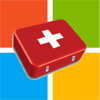So you’ve managed to hose the bootloader on your computer? No worries, every Geek has.
This article will show you how to:
– Fix the Windows Vista bootloader
– Fix the Windows 7 bootloader
– Fix the Windows 8 bootloader
***warning – Messing with this stuff is potentially dangerous to your PC. I am not responsible for what you do.
Option 1 – Standard Bootloader Repair
1 – Boot from the Windows install or repair CD appropriate to you version of Windows.
For Windows 8:
1 – Boot from repair disc > Choose Keyboard type > click Troubleshoot > click Advanced options > choose Automatic Repair
if that fails then use:
2 -Boot from Recovery disc or Install disc
-Boot from repair disc > Chose Keyboard type > click Troubleshoot > click Advanced options > choose Command Prompt
or
-Boot from Install disc > Click Next > click Repair your computer > click Troubleshoot > click Advanced options > choose Command Prompt
type > bootrec /fixmbr (writes mbr but does not overwrite partition table)
type > bootrec /fixboot (writes new boot sector to system partition)
type > bootrec /scanos (scans for other OS’s that you might want to add to bcd)
(personally I find the above unneeded and only use the last step)
type > bootrec /rebuildbcd (scans for other OS’s, unlike rebuildbcd it allows you to select the OS’s you want to add to bcd)
Reboot
For Windows 7 and Windows Vista
Boot from the repair disk > Choose keyboard and click Next > Use recovery tools… and click Next > Windows may find problems fix them and reboot, if it works great. If it didn’t work or it didn’t find problems continue on > choose Command Prompt
or
Boot from the Install disk > Choose keyboard and click Next > Use recovery tools… and click Next > choose Command Prompt
type > bootrec /fixmbr (writes mbr but does not overwrite partition table)
type > bootrec /fixboot (writes new boot sector to system partition)
type > bootrec /scanos (scans for other OS’s that you might want to add to bcd)
(personally I find the above unneeded and use the last step)
type > bootrec /rebuildbcd (scans for other OS’s, unlike rebuildbcd it allows you to select the OS’s you want to add to bcd)
Reboot
For more info see: Use the Bootrec.exe tool in the Windows Recovery Environment to troubleshoot and repair startup issues in Windows
Option 2 – The Nuclear Option
This option is basically going to give you a new MBR and bootloader. I’ve used this quite a bit. Most recently I used it after removing Windows 7 from a dual boot and moving the Windows 8 partition up (via True Image). Anyway boot as above and use these commands:
bootsect /nt60 c: /force /mbr
bcdboot c:\windows /s c:
What these commands do:
Writes a new mbr to c:
bootsect /nt60 c: /force /mbr
( command, /nt60 = use boot code that is compatible with BOOTMGR, / = force dismount, / = write mbr )
( bootsect does to touch mbr, it works on the selected drives…ahem….wait for it…bootsector)
Write a new bootloader to the C: drive
bcdboot c:\windows /s c:
( command, look in c:windows for files, copy files to c: (actually c:\windows\boot) )
For more info see:
Bootsect Command-Line Options
BCDboot Command-Line Options
EasyBCD
For dual-booting and other boot related projects I use EasyBCD.
I highly recommend you check out this FREE program.
Dual-booting as well as bcd backup and repair are just some of the things you can do.
In addition the site is a wealth of information (check out the blog as well as the forums).
-END-
